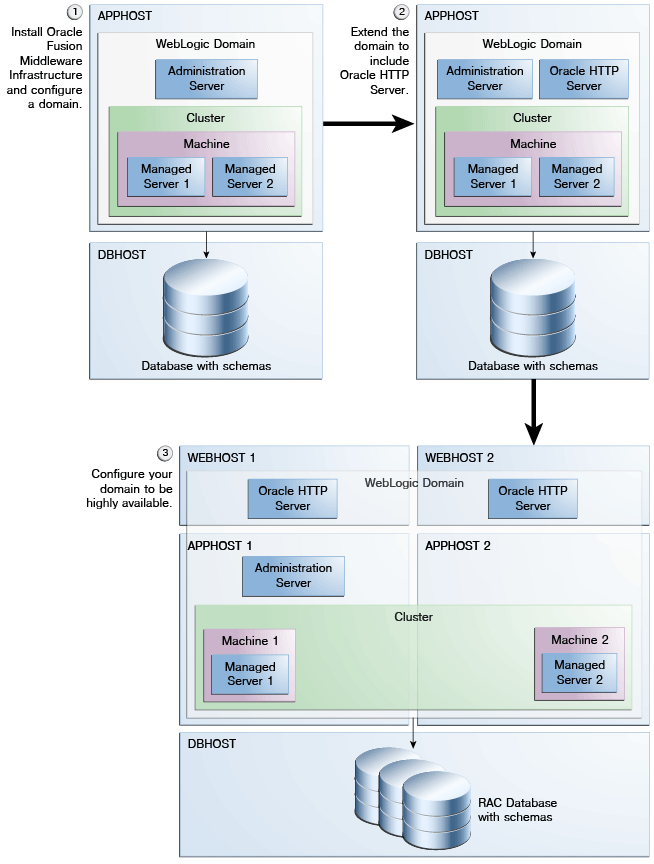2 Understanding the Documentation Roadmap to High Availability
This chapter describes the roadmap of related documents from pre-installation to configuring high availability.
The following sections are included:
-
Section 2.1, "Understanding the Roadmap to High Availability"
-
Section 2.3, "Installing the Oracle Fusion Middleware Infrastructure"
2.1 Understanding the Roadmap to High Availability
Figure 2-1 shows how the standard installation topology for Oracle Fusion Middleware Infrastructure, which contains most of the components required by other Fusion Middleware products, can be configured for high availability. The documentation is designed to take this standard installation topology and arrive at the standard topology for high availability.
Note:
The topologies represented are the defined standard installation topologies (see Section 1.2). As needed, links to additional tasks and documentation are provided should your environment require such additional information to arrive at a high availability environment.
Figure 2-1 Roadmap of Topologies to Arrive at High Availability

Description of "Figure 2-1 Roadmap of Topologies to Arrive at High Availability"
Table 2-1 describes the documentation roadmap for arriving at high availability.
Table 2-1 Documentation Roadmap for Arriving at High Availability
| Task | Description and Additional Documentation |
|---|---|
|
Verify pre-installation requirements. |
|
|
Task 1 in Figure 2-1: install and configure the Oracle Fusion Middleware Infrastructure standard installation topology. |
|
|
Task 2 in Figure 2-1: extend the domain in the Oracle Fusion Middleware Infrastructure standard installation topology to include Oracle HTTP Server. |
|
|
Task 3 in Figure 2-1: use various tools and scripts to move to a high availability environment. |
2.2 Verifying Pre-Installation Requirements
Table 2-2 describes the tasks that can be taken to verify your environment prior to installation.
Table 2-2 Tasks for Verifying Pre-Installation Requirements
| Task | Documentation |
|---|---|
|
Verify that your platform and system are certified and meet the necessary minimum requirements for installation and configuration. |
|
|
Make the necessary preparations in terms of understanding the environment you want to have at the end of your installation and configuration process. |
Planning an Installation of Oracle Fusion Middleware (this document) |
|
Review and understand basic Oracle Fusion Middleware concepts. |
|
|
When you are ready to begin, obtain the necessary software distributions. |
2.3 Installing the Oracle Fusion Middleware Infrastructure
Instructions for installing the first part of the topology, the Oracle Fusion Middleware Infrastructure, are located in Installing and Configuring the Oracle Fusion Middleware Infrastructure.
The standard installation topology for Oracle Fusion Middleware Infrastructure consists of a domain with two Managed Servers; a minimum of two Managed Servers is required for the standard high availability topology.
2.4 Installing Oracle HTTP Server
After configuring the domain for Oracle Fusion Middleware Infrastructure, the post-domain configuration chapter discusses tasks that should be performed to prepare your environment for high availability.
One of these tasks is to extend your domain to include Oracle HTTP Server in a WebLogic Server domain. Instructions for doing this and can be found in Installing and Configuring Oracle HTTP Server.
2.5 Moving to High Availability
After Oracle Fusion Middleware Infrastructure and Oracle HTTP Server are properly installed and configured, you can follow the instructions in either of the respective installation guides to help you move to high availability; the links will point you to the appropriate documentation in the High Availability Guide.
Some of the tasks required include:
-
Adding Oracle RAC database connectivity
-
Adding a load balancer
-
Scaling out a machine